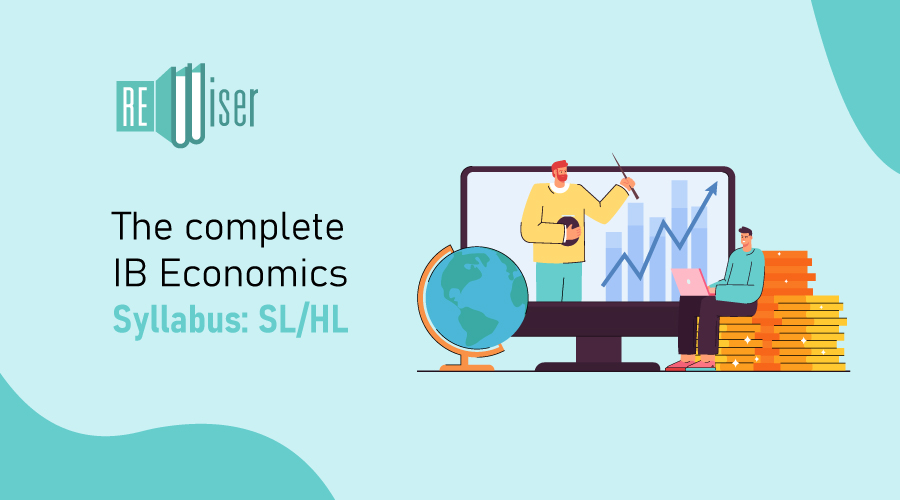
The complete IB Economics Syllabus: SL/HL
The International Baccalaureate (IB) Diploma Program is widely renowned for its accurate and comprehensive curriculum. Among all the subjects of this program, one that often provokes students’ interest is Economics. Whether you’re choosing the Standard Level (SL) or Higher Level (HL), understanding the syllabus in-depth is highly important.
The following article provides a detailed overview of the IB Economics syllabus for both SL and HL to help you navigate your studies correctly.
Table of Contents:
- About IB Economic Curriculum
- About Economics & Key Topics
- About Micro-economics & Key Topics
- About Macro-economics & Key Topics
- Difference between SL and HL Economics for IB Diploma
About IB Economic Curriculum –
The IB Economics course teaches students about money and business topics for both SL and HL levels. However, both levels cover main topics like small-scale economics (microeconomics), big-picture economics (macroeconomics), global trade, and how countries develop. The HL goes even deeper, especially when looking at business theories. The curriculum focuses on thinking deeply, analyzing, and understanding how these topics work in the real world.
About Economics –
Learning economics is usually about understanding how people make choices with limited things like money or goods. The subject helps students to see how things are made, shared, and used by everyone. It also looks at the big picture like job rates or price changes in a country (that’s macroeconomics). Smaller things like how a single shop sets its prices (that’s microeconomics). Economics is about how people, businesses, and governments make decisions about money and goods.
Key topics:
- Scarcity and Choice
- Resource allocation in different economic systems
- Production possibility curves
Microeconomics –
Microeconomics is the study of how people and businesses work in markets. It shows how things are sold and bought and how prices are set. For instance, why would a toy’s price go up if there are only a few left in the store? Students will understand the choices people make when shopkeepers have limited money or resources. The subject formulates various types of models based on logic and observed human behavior.
Key Topics:
- Demand and Supply
- Market Equilibrium
- Elasticities
- Government intervention
- Market failure
- Theory of the Firm
Macroeconomics –
This section deals with the whole country’s money matters and how well it’s doing. Macroeconomics differs from microeconomics, which studies important topics like how individual people make decisions. This part of IB economy covers prices going up or down, and the country’s overall money growth. Instead of just looking at one shop or market, it looks at the big picture of how everything works together. By studying this, leaders can make plans to keep the country’s money stable and help it grow in a good way.
Key Topics for both IB Economics SL/HL:
- Reasons for trade
- Protectionism
- Exchange Rates
- Balance of Payments
- Economic Integration
- Terms of Trade
Also Read – Everything you need to know about the AP Microeconomics Exam
Difference between SL and HL Economics for IB Diploma –
The International Baccalaureate (IB) Diploma offers both Standard Level (SL) and Higher Level (HL) courses in Economics, with key differences in depth, content, and assessment.
In-Depth Content: HL dives deeper into certain topics, particularly areas like the theory of the firm, where HL students explore advanced topics like oligopolies, monopolistic competition, and game theory, which aren’t extensively covered in SL.
Duration of Course: HL courses generally have more teaching hours compared to SL, allowing for a broader and more in-depth exploration of topics.
Assessment: While both SL and HL students sit for Papers 1 and 2, only HL students tackle Paper 3, which focuses on quantitative aspects of the syllabus.
Internal Assessment: Though both levels require an internal assessment, HL often demands a more detailed and comprehensive economic commentary.
While both SL and HL provide a foundational understanding of economics, HL is more rigorous and expansive, catering to those with a stronger inclination toward the subject.
If you need additional support for your IB Economics Syllabus both SL/HL, then you can contact Team ReWiser: Contact Us – ReWiser
Final thought –The IB Economics course, for both SL and HL, teaches students about how the world’s money and businesses work. It helps students think, talk about, and guess future money trends, from small shops to big global changes. To do well in this subject, like other IB topics, students need to study on their own, think deeply, and review often. By studying this, students can do well in exams and also understand the world’s money matters better.

